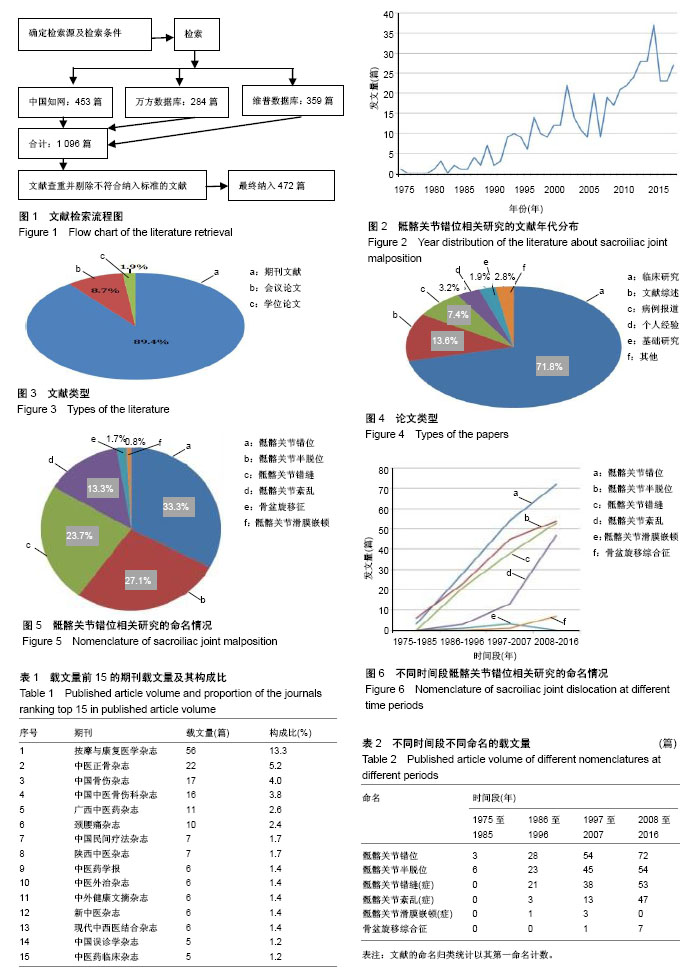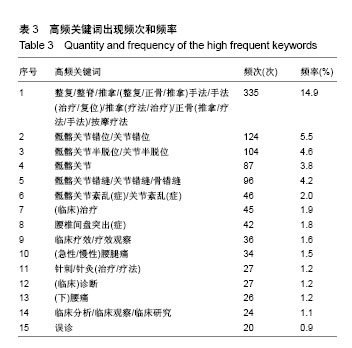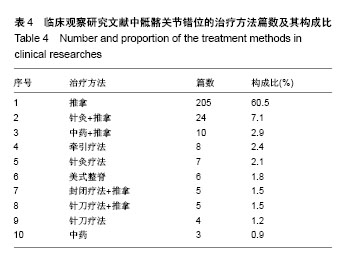中国组织工程研究 ›› 2018, Vol. 22 ›› Issue (27): 4316-4321.doi: 10.3969/j.issn.2095-4344.0345
• 骨科植入物 orthopedic implant • 上一篇 下一篇
基于文献计量学分析骶髂关节错位的历史沿革
张少群,李乃奇,祁 冀,李义凯
- 南方医科大学中医药学院,广东省广州市 510515
Historical evolution of sacroiliac joint malposition based on bibliometric analysis
Zhang Shao-qun, Li Nai-qi, Qi Ji, Li Yi-kai
- School of Traditional Chinese Medicine, Southern Medical University, Guangzhou 510515, Guangdong Province, China
摘要:
文章快速阅读:
.jpg)
文题释义:
骶髂关节错位:是指在外力和其他致病因素作用下,骶骨和髂骨耳状面及关节周围的韧带、肌肉受损,关节活动超出生理范围,并使耳状面产生微小移动不能自行复位,导致该关节内外力学环境失衡及相关软组织损伤,并出现临床症状的一种疾病。
文献计量学分析:是指用数学和统计学的方法,定量地分析一切知识载体的交叉科学,它是集数学、统计学、文献学为一体,注重量化的综合性知识体系,是基于文献事实,客观定量地反映学科的整体布局,揭示新理论发展的方向的一种文献分析方法。
摘要
背景:骶髂关节错位命名混乱、治疗方法种类繁多,目前国内对于骶髂关节错位的研究历史沿革和研究现状还缺乏客观、量化的总结和分析。
目的:分析骶髂关节错位相关研究的历史沿革,探讨骶髂关节错位的研究动态和发展趋势。
方法:检索中国知网、万方数据库和维普数据库建库至2016年12月31日期间公开发表的关于骶髂关节错位的相关文献,检索词为“骶髂关节错位,骶髂关节半脱位,骶髂关节错缝,骶髂关节紊乱,骶髂关节滑膜嵌顿”采用文献计量学方法分析相关文献的年代分布、文献类型、期刊分布、骶髂关节错位的命名及其治疗方法、高频关键词等的特点。
结果与结论:①初检获得的文献1 096篇,根据纳入和排除标准最后共获得472篇文献;②骶髂关节错位的相关研究在2013年达到高峰(37篇,7.8%),2000至2016年共发表论文354篇(75.0%);③文献中期刊论文最多(89.4%),其次是会议论文(8.7%);其中临床观察研究占71.8%,而基础研究仅占1.9%;④472篇文献共分布于159种期刊上,《按摩与康复医学杂志》、《中医正骨杂志》和《中国骨伤杂志》的载文量分别为13.3%,5.2%和4.0%,高于其他期刊;⑤骶髂关节错位相关文献的命名以骶髂关节错位命名的占33.3%,骶髂关节半脱位占27.1%,骶髂关节错缝占23.7%;⑥整复/整脊/推拿/按摩疗法是出现频率最高的关键词;⑦骶髂关节错位的治疗方法中,推拿治疗占60.5%,针灸+推拿治疗占7.1%,中药+推拿治疗占2.9%,高于其他治疗方法。⑧结果提示,近40余年骶髂关节错位的相关研究整体呈上升趋势,2000年以后骶髂关节错位研究进入热门时期,但研究以临床观察研究为主,缺乏基础研究;骶髂关节错位命名混乱,但主要以骶髂关节错位和骶髂关节半脱位命名为主;推拿是骶髂关节错位的主要治疗方法,但有关推拿治疗骶髂关节错位作用机制的研究较少,有待进一步深入研究。
中国组织工程研究杂志出版内容重点:人工关节;骨植入物;脊柱;骨折;内固定;数字化骨科;组织工程
ORCID: 0000-0003-1352-2353(李义凯)
中图分类号:



.jpg)